HONDA RIDGELINE 2017 2.G Owners Manual
Manufacturer: HONDA, Model Year: 2017, Model line: RIDGELINE, Model: HONDA RIDGELINE 2017 2.GPages: 606, PDF Size: 13.21 MB
Page 581 of 606
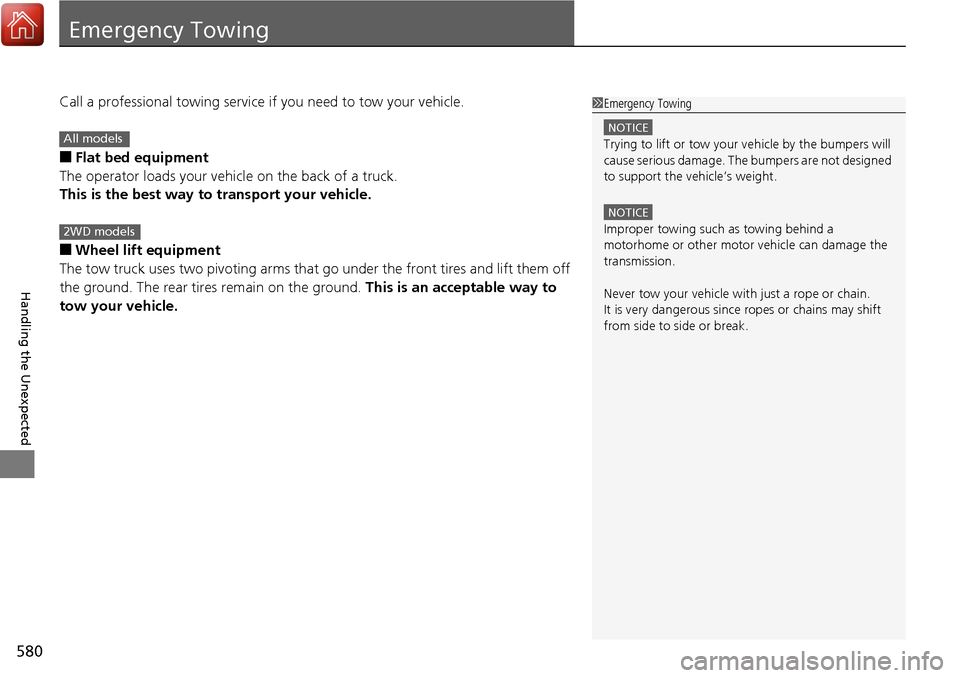
580
Handling the Unexpected
Emergency Towing
Call a professional towing service if you need to tow your vehicle.
■Flat bed equipment
The operator loads your vehicle on the back of a truck.
This is the best way to transport your vehicle.
■Wheel lift equipment
The tow truck uses two pivoti ng arms that go under the front tires and lift them off
the ground. The rear tires remain on the ground. This is an acceptable way to
tow your vehicle.
1 Emergency Towing
NOTICE
Trying to lift or tow your vehicle by the bumpers will
cause serious damage. The bumpers are not designed
to support the vehicle’s weight.
NOTICE
Improper towing such as towing behind a
motorhome or other motor vehicle can damage the
transmission.
Never tow your vehicle with just a rope or chain.
It is very dangerous since ropes or chains may shift
from side to side or break.
All models
2WD models
Page 582 of 606
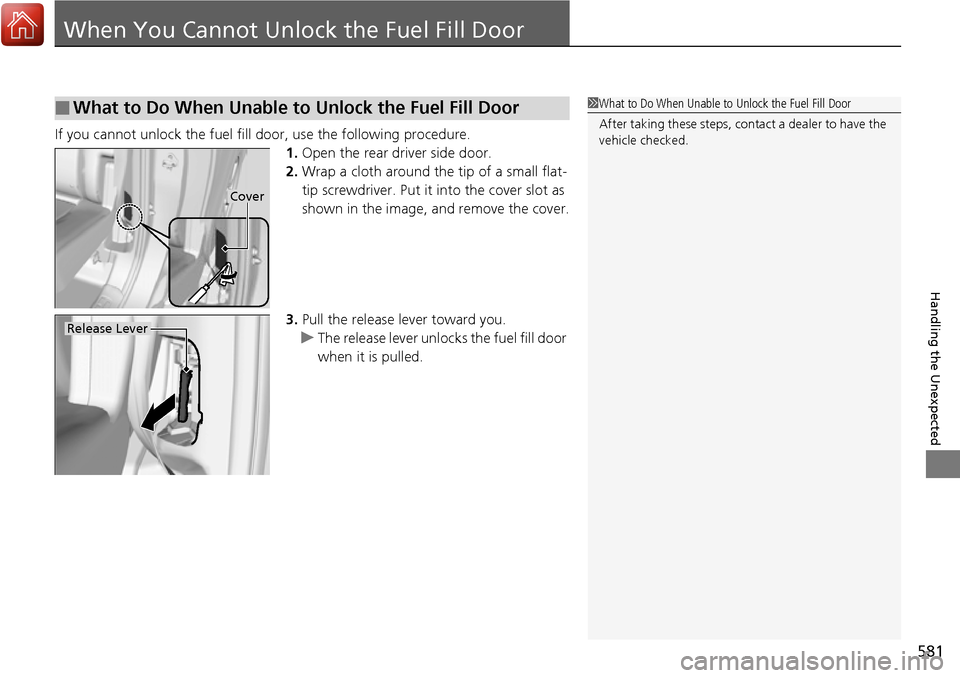
581
Handling the Unexpected
When You Cannot Unlock the Fuel Fill Door
If you cannot unlock the fuel fill door, use the following procedure.
1.Open the rear driver side door.
2. Wrap a cloth around the tip of a small flat-
tip screwdriver. Put it into the cover slot as
shown in the image, and remove the cover.
3. Pull the release lever toward you.
u The release lever unlocks the fuel fill door
when it is pulled.
■What to Do When Unable to Unlock the Fuel Fill Door1What to Do When Unable to Unlock the Fuel Fill Door
After taking these steps, cont act a dealer to have the
vehicle checked.
Cover
Release Lever
Page 583 of 606
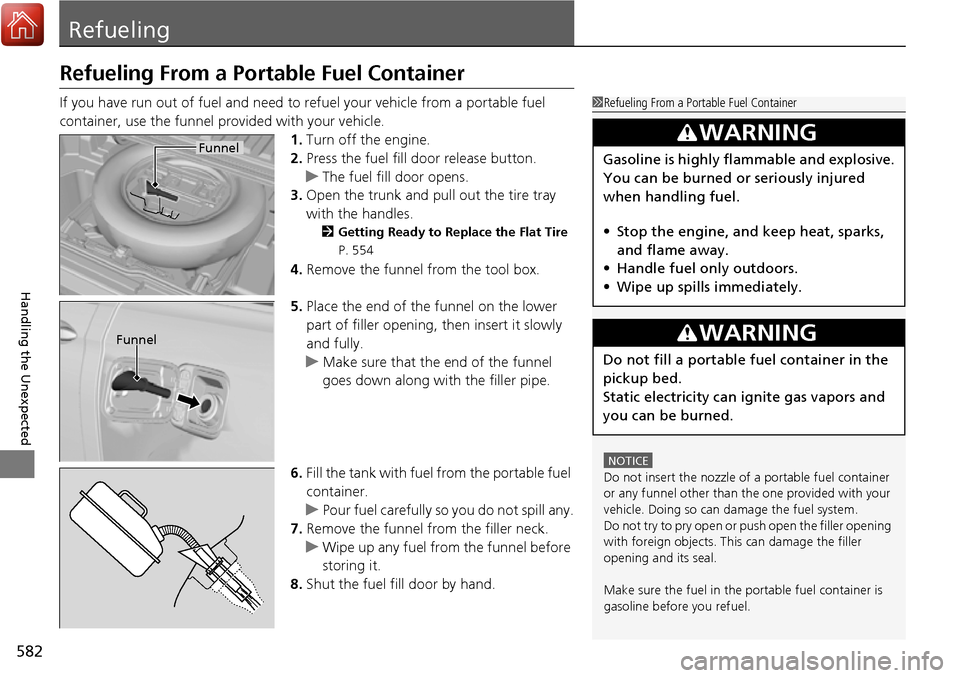
582
Handling the Unexpected
Refueling
Refueling From a Portable Fuel Container
If you have run out of fuel and need to refuel your vehicle from a portable fuel
container, use the funnel provided with your vehicle.1.Turn off the engine.
2. Press the fuel fill door release button.
u The fuel fill door opens.
3. Open the trunk and pull out the tire tray
with the handles.
2 Getting Ready to Replace the Flat Tire
P. 554
4. Remove the funnel from the tool box.
5. Place the end of the funnel on the lower
part of filler opening, then insert it slowly
and fully.
u Make sure that the end of the funnel
goes down along with the filler pipe.
6. Fill the tank with fuel from the portable fuel
container.
u Pour fuel carefully so you do not spill any.
7. Remove the funnel from the filler neck.
u Wipe up any fuel from the funnel before
storing it.
8. Shut the fuel fill door by hand.
1Refueling From a Portable Fuel Container
NOTICE
Do not insert the nozzle of a portable fuel container
or any funnel other than the one provided with your
vehicle. Doing so can damage the fuel system.
Do not try to pry open or push open the filler opening
with foreign objects. This can damage the filler
opening and its seal.
Make sure the fuel in the portable fuel container is
gasoline before you refuel.
3WARNING
Gasoline is highly flammable and explosive.
You can be burned or seriously injured
when handling fuel.
• Stop the engine, and keep heat, sparks,
and flame away.
• Handle fuel only outdoors.
• Wipe up spills immediately.
3WARNING
Do not fill a portable fuel container in the
pickup bed.
Static electricity can ignite gas vapors and
you can be burned.
Funnel
Funnel
Page 584 of 606
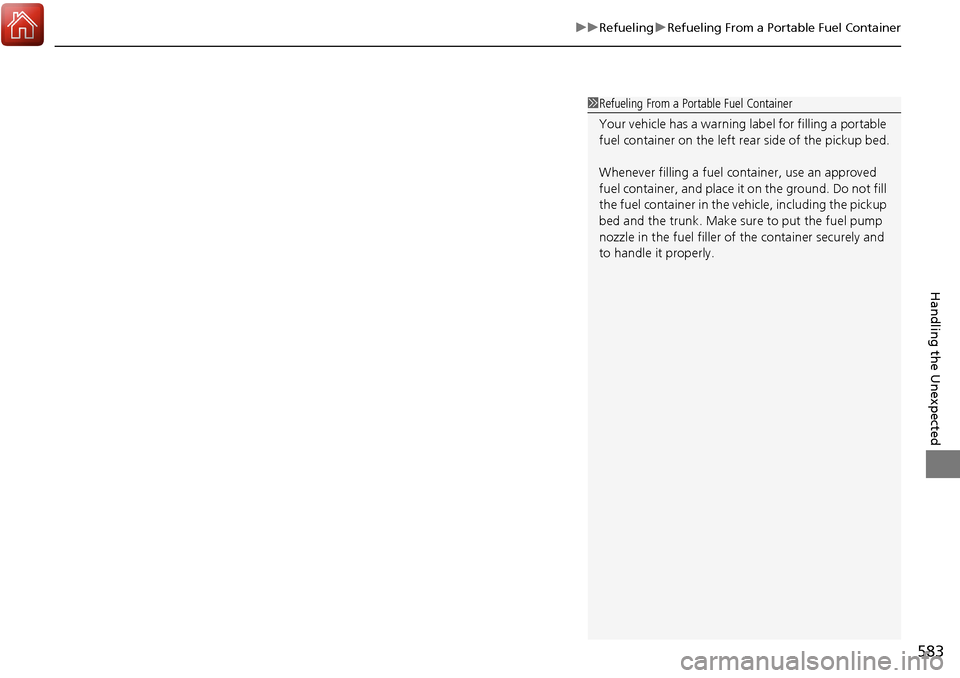
583
uuRefueling uRefueling From a Portable Fuel Container
Handling the Unexpected
1Refueling From a Portable Fuel Container
Your vehicle has a warning label for filling a portable
fuel container on the left rear side of the pickup bed.
Whenever filling a fuel container, use an approved
fuel container, and place it on the ground. Do not fill
the fuel container in the vehicle, including the pickup
bed and the trunk. Make sure to put the fuel pump
nozzle in the fuel filler of the container securely and
to handle it properly.
Page 585 of 606
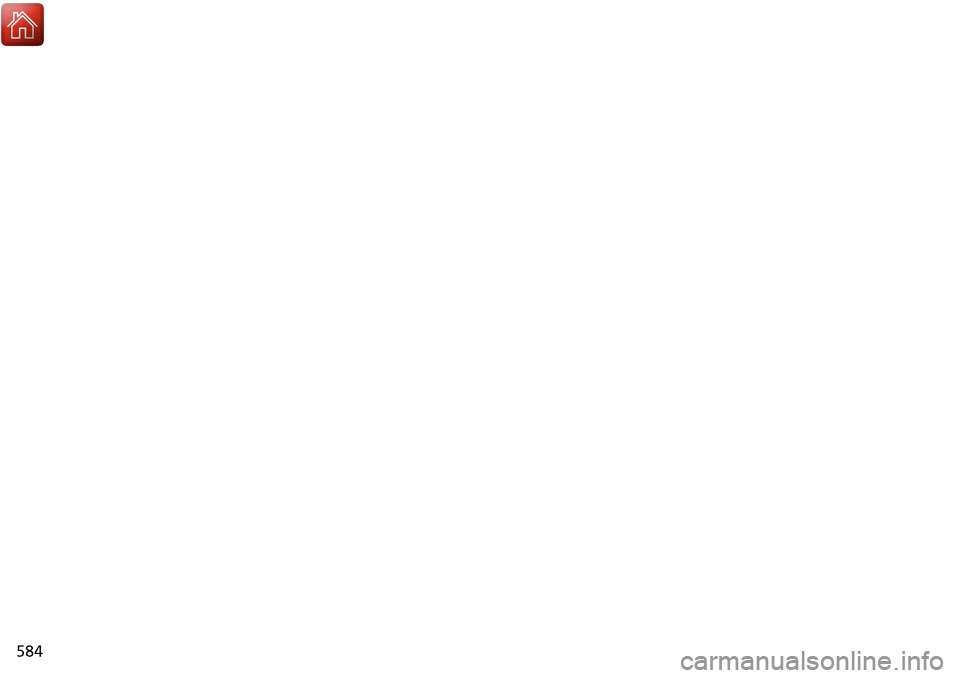
584
Page 586 of 606
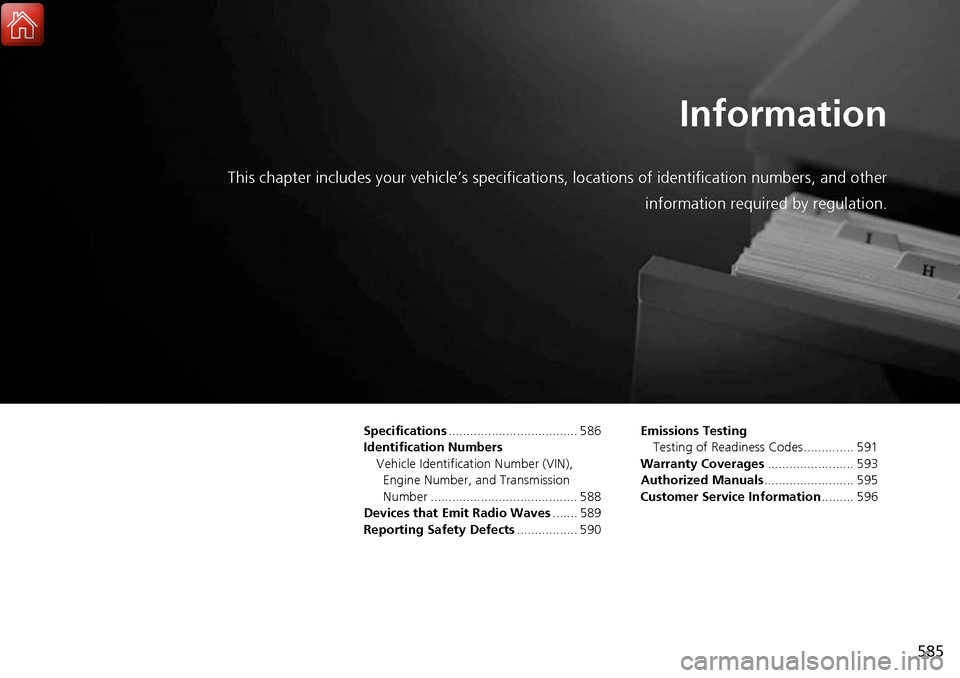
585
Information
This chapter includes your vehicle’s specifications, locations of identification numbers, and other
information required by regulation.
Specifications .................................... 586
Identification Numbers Vehicle Identification Number (VIN), Engine Number, and Transmission
Number ......................................... 588
Devices that Emit Radio Waves ....... 589
Reporting Safety Defects ................. 590Emissions Testing
Testing of Readiness Codes.............. 591
Warranty Coverages ........................ 593
Authorized Manuals ......................... 595
Customer Service Information ......... 596
Page 587 of 606
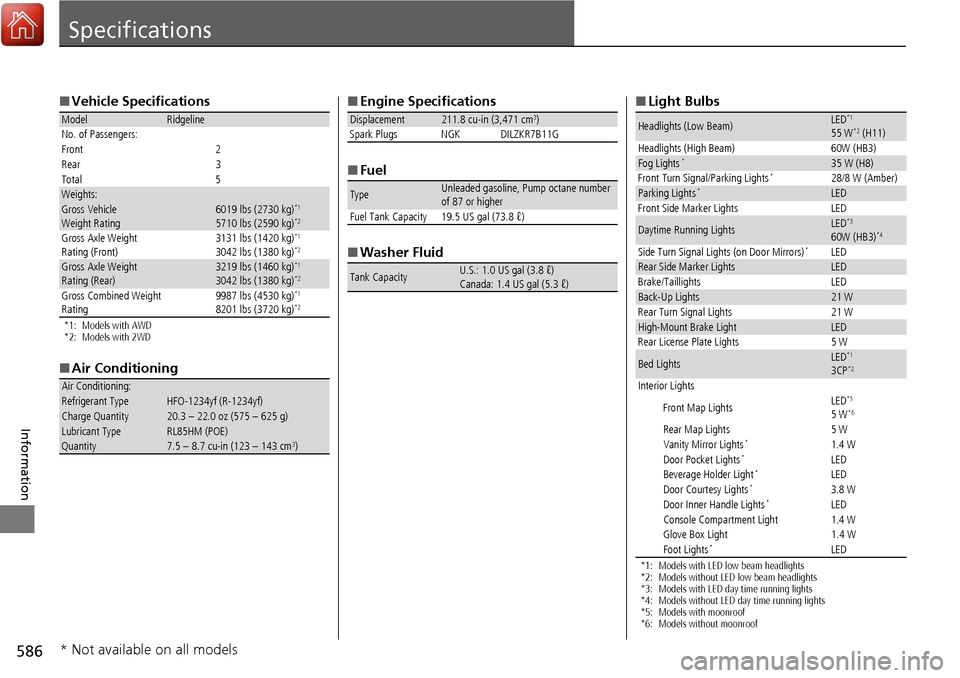
586
Information
Specifications
■Vehicle Specifications
*1: Models with AWD
*2: Models with 2WD
■Air Conditioning
ModelRidgeline
No. of Passengers:
Front 2
Rear 3
Total 5
Weights:Gross Vehicle
Weight Rating6019 lbs (2730 kg)*1
5710 lbs (2590 kg)*2
Gross Axle Weight
Rating (Front)3131 lbs (1420 kg)*1
3042 lbs (1380 kg)*2
Gross Axle Weight
Rating (Rear)3219 lbs (1460 kg)*1
3042 lbs (1380 kg)*2
Gross Combined Weight
Rating 9987 lbs (4530 kg)*1
8201 lbs (3720 kg)*2
Air Conditioning:Refrigerant TypeHFO-1234yf (R-1234yf)Charge Quantity20.3 – 22.0 oz (575 – 625 g)Lubricant TypeRL85HM (POE)Quantity7.5 – 8.7 cu-in (123 – 143 cm3)
■
Engine Specifications
■ Fuel
■ Washer Fluid
Displacement211.8 cu-in (3,471 cm3)
Spark Plugs NGK DILZKR7B11G
TypeUnleaded gasoline, Pump octane number
of 87 or higher
Fuel Tank Capacity 19.5 US gal (73.8 ℓ)
Tank CapacityU.S.: 1.0 US gal (3.8 ℓ)
Canada: 1.4 US gal (5.3 ℓ)
■ Light Bulbs
*1: Models with LED low beam headlights
*2: Models without LED low beam headlights
*3: Models with LED day time running lights
*4: Models without LED day time running lights
*5: Models with moonroof
*6: Models without moonroof
Headlights (Low Beam)LED*1
55 W*2 (H11)
Headlights (High Beam) 60W (HB3)
Fog Lights*35 W (H8)
Front Turn Signal/Parking Lights*28/8 W (Amber)Parking Lights*LED
Front Side Marker Lights LED
Daytime Running LightsLED*3
60W (HB3)*4
Side Turn Signal Lights (on Door Mirrors)*LEDRear Side Marker LightsLED
Brake/Taillights LED
Back-Up Lights21 W
Rear Turn Signal Lights 21 W
High-Mount Brake LightLED
Rear License Plate Lights 5 W
Bed LightsLED*1
3CP*2
Interior Lights
Front Map Lights LED*5
5 W*6
Rear Map Lights
5 W
Vanity Mirror Lights*1.4 W
Door Pocket Lights*LED
Beverage Holder Light*LED
Door Courtesy Lights*3.8 W
Door Inner Handle Lights*LED
Console Compartment Light 1.4 W
Glove Box Light 1.4 W
Foot Lights
*LED
* Not available on all models
Page 588 of 606
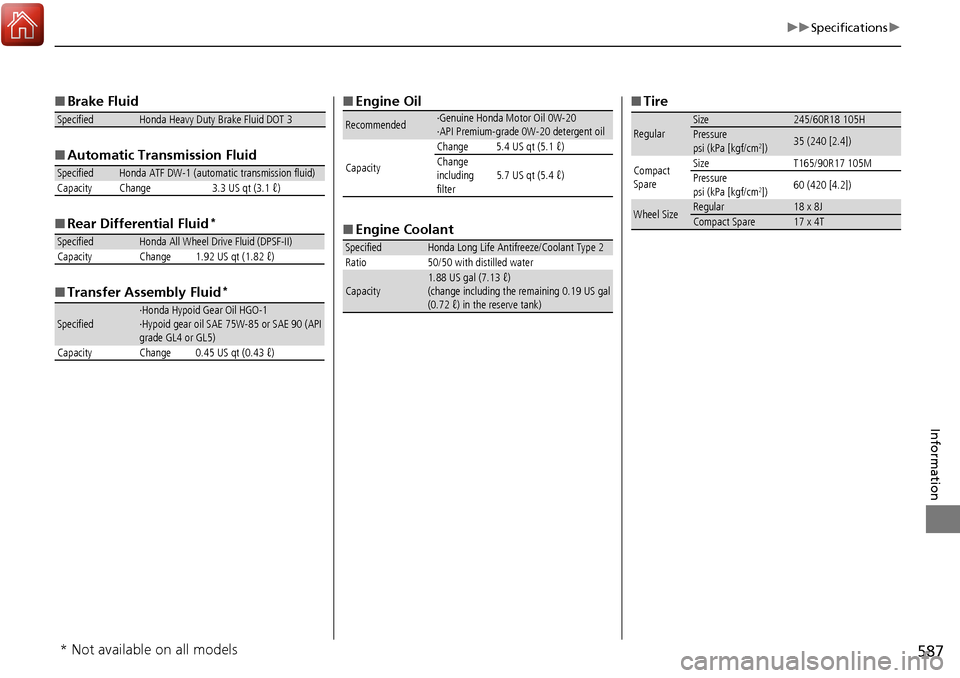
587
uuSpecifications u
Information
■Brake Fluid
■ Automatic Transmission Fluid
■ Rear Differential Fluid
*
■Transfer Assembly Fluid*
SpecifiedHonda Heavy Duty Brake Fluid DOT 3
SpecifiedHonda ATF DW-1 (automatic transmission fluid)
Capacity Change 3.3 US qt (3.1 ℓ)
SpecifiedHonda All Wheel Drive Fluid (DPSF-II)
Capacity Change 1.92 US qt (1.82 ℓ)
Specified·Honda Hypoid Gear Oil HGO-1
·Hypoid gear oil SAE 75W-85 or SAE 90 (API
grade GL4 or GL5)
Capacity Change 0.45 US qt (0.43 ℓ)
■ Engine Oil
■ Engine Coolant
Recommended·Genuine Honda Motor Oil 0W-20
·API Premium-grade 0W-20 detergent oil
Capacity Change 5.4 US qt (5.1 ℓ)
Change
including
filter
5.7 US qt (5.4 ℓ)
SpecifiedHonda Long Life Antifreeze/Coolant Type 2
Ratio 50/50 with distilled water
Capacity1.88 US gal (7.13 ℓ)
(change including the remaining 0.19 US gal
(0.72 ℓ) in the reserve tank)
■ Tire
RegularSize245/60R18 105HPressure
psi (kPa [kgf/cm2])35 (240 [2.4])
Compact
Spare Size
T165/90R17 105M
Pressure
psi (kPa [kgf/cm
2]) 60 (420 [4.2])
Wheel SizeRegular18 x 8JCompact Spare17 x 4T
* Not available on all models
Page 589 of 606
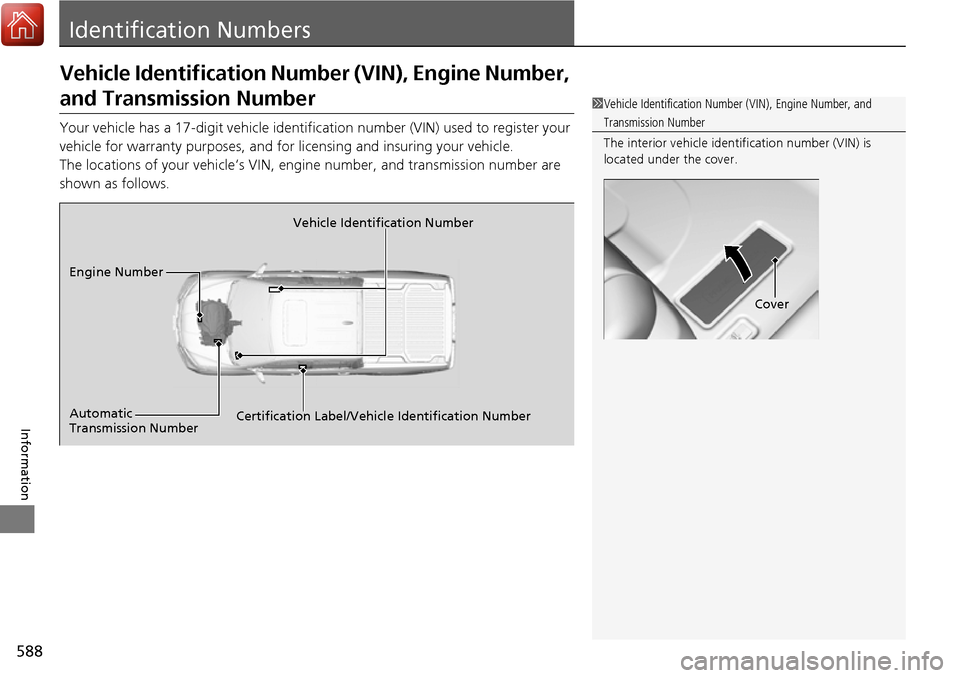
588
Information
Identification Numbers
Vehicle Identification Number (VIN), Engine Number,
and Transmission Number
Your vehicle has a 17-digit vehicle identification number (V IN) used to register your
vehicle for warranty purposes, and for licensing and insuring your vehicle.
The locations of your vehicle’s VIN, en gine number, and transmission number are
shown as follows.
1 Vehicle Identification Number (VIN), Engine Number, and
Transmission Number
The interior vehicle identification number (VIN) is
located under the cover.
Cover
Vehicle Identification Number
Engine Number
Certification Label/Vehicle Identification Number
Automatic
Transmission Number
Page 590 of 606
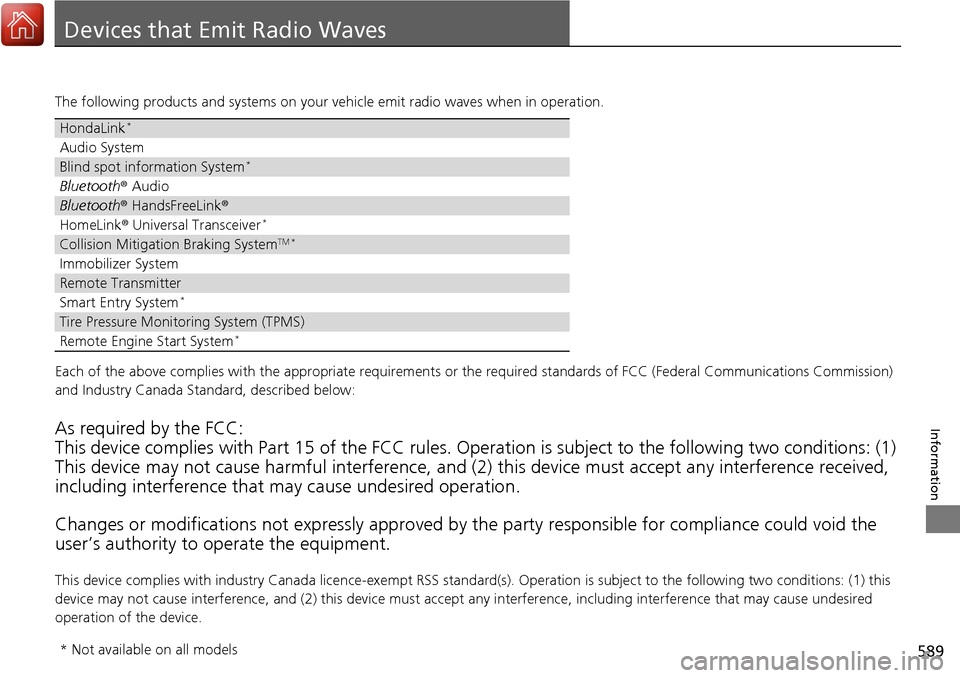
589
Information
Devices that Emit Radio Waves
The following products and systems on your vehicle emit radio waves when in operation.
Each of the above complies with the appropriate requirements or the required standards of FCC (Federal Communications Commission)
and Industry Canada Standard, described below:
As required by the FCC:
This device complies with Part 15 of the FCC rules. Operation is subject to the following two conditions: (1)
This device may not cause harmful interference, and (2) this device must accept any interference received,
including interference that may cause undesired operation.
Changes or modifications not expres sly approved by the party responsible for compliance could void the
user’s authority to operate the equipment.
This device complies with indus try Canada licence-exempt RSS standard(s). Operation is subject to the following two conditions: (1) this
device may not cause interference, and (2) this device must ac cept any interference, including interference that may cause unde sired
operation of the device.
HondaLink*
Audio System
Blind spot information System*
Bluetooth ® Audio
Bluetooth® HandsFreeLink ®
HomeLink® Universal Transceiver*
Collision Mitigation Braking SystemTM *
Immobilizer System
Remote Transmitter
Smart Entry System*
Tire Pressure Monitoring System (TPMS)
Remote Engine Start System*
* Not available on all models